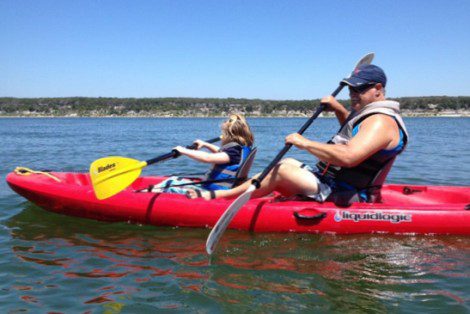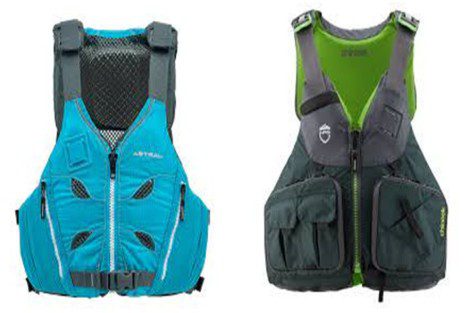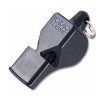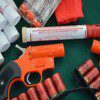 By Bob Currie, Recreational Boating Safety Specialist
By Bob Currie, Recreational Boating Safety Specialist
U. S. Coast Guard Auxiliary Station Galveston Flotilla
Congratulations if you are the new owner of a kayak. You most likely have many questions, and I would like to take the time in this column to answer as many as possible. This column will explain the registration requirements (if any), the required equipment, and recommended equipment. The assumption will be that you have a kayak but no equipment, and that you wish to take the economic route until you decide for sure that kayaking is for you. For the purposes of this column, all rules and requirements discussed will be federal (Coast Guard) requirements. Most states follow the federal requirements, but it is up to you to check for any additional state requirements.
The Station Galveston Flotilla of the US Coast Guard Auxiliary operates out of the USCG Station Galveston base on Galveston Island. They aid the Coast Guard by providing maritime observation patrols in Galveston Bay; by providing recreational boating vessel safety checks; and by working alongside Coast Guard members in maritime accident investigation, small boat training, providing a safety zone, Aids to Navigation verification, in the galley, on the Coast Guard Drone Team and watch standing.

Kayak Registration
Do you have to register your kayak with the state? It depends. Except for the six states listed below, you do not have to register your kayak with the state as long as your only method of propulsion is you. As soon as you add a motor to it, it becomes a requirement to register it as a power boat. This requirement includes trolling motors and outboard motors. The six states that have registration requirements for kayaks are Iowa, Illinois, Minnesota, Ohio, Pennsylvania, and Wisconsin. Each state’s requirements are different, so be sure to check the regulations for the state in which you wish to kayak. If your situation is such that registration is required, be sure to explicitly follow the instructions for placing your numbers and registration stickers on your kayak. There are specific requirements for number and letter spacing, font, color, and registration sticker placement.
Required Equipment
The federal required equipment list for kayaks is quite simple. If you are operating in daylight hours only, then you are required to haver a Coast Guard approved personal flotation device (aka life jacket) and a sound producing device (whistle is best). If operating at night then you must have a white light and visual distress signals (VDS).
Personal Flotation Device
Children under 13 are required to wear their properly fitting PFD at all times when aboard a kayak. Keeping in mind that nine out of ten people who drown were not wearing a PFD, I highly advise you to wear your PFD at all times. If you capsize your kayak (and you will) you will find it nearly impossible to put your PFD on while in the water. What about the ten percent who drowned while wearing a PFD? How does that happen? Simple: if you are knocked unconscious (it happens a lot!) and your PFD is one that is not designed to keep an unconscious person’s head above water, you will drown. When you are choosing a PFD, read the label printed on the PFD. It will tell you if the PFD is designed to keep your head above water or not. Yes there is a difference- while all PFDs will keep you afloat, not all will return the head of an unconscious person to a face up position. There are special PFDs designed for kayakers. In general, they have large arm cutouts to make it easier to paddle, and they have mesh in the rear so that you can sit more comfortably.

Sound Signal
 Operators of non-motorized boats are required to have some means of making a detectable oral or mechanical sound signal that can be heard from no less than one-half mile away, such as a whistle or a horn. Ideally it is attached to your life jacket. Although just about any whistle will do, a pea-less whistle is highly recommended. Old style whistles have a ball-shaped piece of cork in them that helps make the whistle loud. That piece of cork deteriorates quickly when it is exposed to water. Newer models such as the Fox40 whistle do not have a pea and are not affected by immersion in water. Attach your whistle to your PFD. You will always have it handy that way.
Operators of non-motorized boats are required to have some means of making a detectable oral or mechanical sound signal that can be heard from no less than one-half mile away, such as a whistle or a horn. Ideally it is attached to your life jacket. Although just about any whistle will do, a pea-less whistle is highly recommended. Old style whistles have a ball-shaped piece of cork in them that helps make the whistle loud. That piece of cork deteriorates quickly when it is exposed to water. Newer models such as the Fox40 whistle do not have a pea and are not affected by immersion in water. Attach your whistle to your PFD. You will always have it handy that way.
White Light for Night
 I have seen a lot of kayaks equipped with navigation lights. You only need navigation lights on your kayak if you add a motor or engine to it and thus it becomes a powerboat. Otherwise, all you need is a white light (illustrated below) displayed in time to prevent a collision. There are some all round white lights designed to attach to kayaks, and they do the job quite well. You might consider investing in such a light if you plan to kayak at night.
I have seen a lot of kayaks equipped with navigation lights. You only need navigation lights on your kayak if you add a motor or engine to it and thus it becomes a powerboat. Otherwise, all you need is a white light (illustrated below) displayed in time to prevent a collision. There are some all round white lights designed to attach to kayaks, and they do the job quite well. You might consider investing in such a light if you plan to kayak at night.
Visual Distress Signals
 Recreational vessels less than 16 feet in length, and most kayaks fit this description, are not required to carry daytime visual distress signals. This is one case where it doesn’t matter if you have a motor or not. Length is the only determining factor. If you plan to operate between sunset and sunrise (aka “nighttime”), then you must carry Coast Guard approved and unexpired nighttime visual distress signals. Nighttime visual distress signals include pyrotechnic devices such as flares, pistol rockets, and parachute rockets, among others. You need three flares, minimum. They are stamped with an expiration date of 42 months (3 1/2 years from the date they were manufactured).
Recreational vessels less than 16 feet in length, and most kayaks fit this description, are not required to carry daytime visual distress signals. This is one case where it doesn’t matter if you have a motor or not. Length is the only determining factor. If you plan to operate between sunset and sunrise (aka “nighttime”), then you must carry Coast Guard approved and unexpired nighttime visual distress signals. Nighttime visual distress signals include pyrotechnic devices such as flares, pistol rockets, and parachute rockets, among others. You need three flares, minimum. They are stamped with an expiration date of 42 months (3 1/2 years from the date they were manufactured).
Recommended Equipment
Although most of the items listed below are recommended for any time of year, many of the items become more important when the weather and water temperatures are cooler.
1. Signaling mirror
2. Marine VHF/FM radio with Digital Selective Calling
3. Spare paddle (I had a paddle blade break off while I was about 3 miles offshore)
4. Paddle tether (most paddles don’t float)
5. Hat (protect your ears from the sun also)
6. UV eye protection (sunglasses)
7. Sunscreen (you can burn even in winter)
8. Drinking water and snacks
9. Proper footwear (flip flops won’t cut it; think oyster shell bottom)
10. Knife (a fixed blade is better than a folding blade in emergencies)
11. Self-rescue devices (tow rope, throwbag with line, duct tape)
12. Dry bag with spare clothing and towel
13. Compass (if fog sets in, you are going to need it)
14. First aid kit (rope burns, lacerations)
Further Recommendations
Now that you know what items you are required to have and what items are recommended, I have a few more recommendations for you to help make you a safe kayaker.
File a Float Plan
Paddle craft operators should regularly file a float plan before using their vessels, even for short trips. It can be an informal document to tell a person on shore where the operator is planning to go, what time he or she is likely to return, which authorities to call if the boat does not return as scheduled, and how to describe the vessel to first-responders. The best float plan I have ever seen is included in the Coast Guard app that you can download to your cell phone.
Be Visible to Other Boaters
Paddlers should take steps to ensure that boaters in larger vessels will be able to see them relatively easily, even in rough water, high traffic areas, and reduced visibility. That means wearing high visibility clothing and accessories whenever possible.
Check the Weather Forecast
Do not kayak in windy weather. Even powerboaters know to avoid windy weather. Obtain an accurate forecast and monitor the weather using the weather channel on your marine radio, and scan the sky frequently for bad weather developing, especially between you and the shore. If the weather changes for worse, head for shore.
Don’t Kayak Alone
You should never launch your kayak without a partner. Your kayaking partners should have their own kayaks as well. I have a kayak designed for either solo or two person operation. Wintertime is not the time to double up in a kayak. That kayaking partner is of no help to you if they are in the boat with you when it capsizes.
No Alcohol
An impaired kayaker is at the highest risk for a serious accident before they even hit the water. Not only is your judgment seriously compromised, so is your ability to survive an immersion. An alcohol-impaired kayaker is more likely to drown due to the gasp reflex than a sober kayaker. The gasp reflex causes you to inhale water when you are suddenly immersed in water that is cold or even cool.
Stay Close to Shore
As you travel away from the shore, make sure you have the strength and skills to paddle back. Stay away from all boats and traffic patterns. If you need to cross the Intracoastal Waterway, do it quickly and when there is no traffic approaching. Stay apprised of tidal currents, also known as rip currents, and their effects on you and your kayak. Tidal currents are part of the danger at San Luis Pass. If in doubt, don’t go out.
Pay the Launch Fee
Although it is easy to drag a kayak to just about any place to launch it, many people launch at boat ramps. Often these ramps are private ramps that have a launch fee. If you launch at a ramp that has a fee, you must pay the launch fee unless the owner says otherwise. Launching your kayak without paying the fee is theft of services and makes a bad name for kayakers.
Summary
Part of the allure of paddle craft is the ability to simply put it in the water anywhere and take off. Resist this temptation unless you have taken the time to prepare for your safety. Take a kayaking course. Take a safe boating course. Both types of courses are available for free online.
For more information on boating safety, please visit the Official Website of the U.S. Coast Guard’s Boating Safety Division at www.uscgboating.org. Questions about the US Coast Guard Auxiliary or our free Vessel Safety Check program may be directed to me at [email protected]. SAFE BOATING!
[Dec-28-2021]

 Posted in
Posted in 























